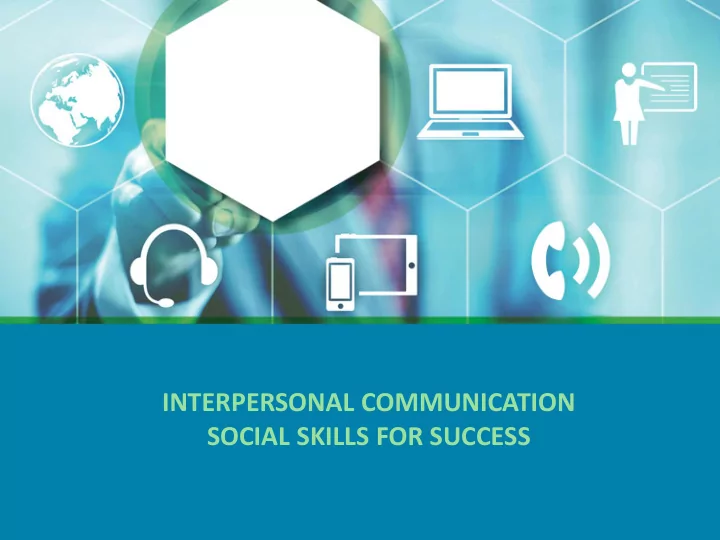

INTERPERSONAL COMMUNICATION SOCIAL SKILLS FOR SUCCESS
PRESENTER Stephen Sandridge Stephen Sandridge holds a Bachelor of Science degree in Communications with a concentration in Broadcasting from Toccoa Falls College in Georgia. He is currently the Team Lead of the United States intakes team at Workplace Options. Stephen has been with Workplace Options for over 6 years and in his current position he oversees the production and quality of inbound phone staff and also provides support for intake-related issues. On a personal note, Stephen has 4 adopted children from Uganda. He also probably knows the name of that guy in that movie that you are having a hard time remembering!
LEARNING OBJECTIVES • Understand the importance of effective communication • Learn how to prevent sender-receiver disconnect • Identify the traits associated with active listening • Discover the SOLER Model • Establish important tips for verbal communication • Consider how to manage your nonverbal cues • Discover how to effectively communicate during conflict
What is communication?
COMMUNICATION IS CRITICAL FOR SOCIAL SUCCESS Communication is the exchange of thoughts, information, and opinions. Communication exists on three levels. 1. What the speaker is saying 2. What the speaker thinks he or she is saying 3. What the listener thinks the speaker is saying (It’s not what the speaker says that counts, but what the listener hears)
FORMS OF COMMUNICATION One-Way Two-Way Communication: Communication: Speaker and/or Speaker and listener listener do not engage in engage in communication. communication.
VERBAL COMMUNICATION: THINGS TO CONSIDER • Voice tone • Voice speed • Voice volume • Language • Vocabulary • Grammar
VERBAL COMMUNICATION: 7 TOP TIPS 1. Expand your vocabulary. 2. Be concise. 3. Plan and prepare. 4. Choose to listen. 5. Be honest. 6. Seek to understand. 7. Consider other perspectives.
POLL It’s not what you say but how you say it that has the greatest impact. A. Agree B. Disagree
NONVERBAL COMMUNICATION • Communication that makes meaning without words permeates every part of our lives. • Communication can include facial expressions, gestures, our use of time and space, and even our pauses and vocal intonations. • Even if you are having a difficult time communicating, sometimes a genuine smile can alleviate the pressure of miscommunication. When in doubt, offer a genuine smile.
NONVERBAL COMMUNICATION
THE BASICS OF NONVERBAL COMMUNICATION 4 TIPS
SENDER/RECEIVER DISCONNECT Two leading causes of communication breakdowns and misunderstandings • Listening barriers • Contradictory messages Solutions • Discard bad listening habits • Build effective listening skills • Learn to read body language
BARRIERS • Language differences • Cultural differences • Physical structures Message Message • Communications Sent Received Barrier
“Seek first to understand, then to be understood.” Stephen Covey
REFLECTION ACTIVITY “People may not remember what you say, but they will always remember how you made them feel.” Anonymous • Think of a time you were made to feel uncomfortable by another person’s actions or behavior. • How did it make you feel?
BUILDING RELATIONSHIPS THROUGH COMMUNICATING "The most basic of all human needs is the need to understand and be understood. The best way to understand people is to listen to them." Ralph Nichols
LISTENING ESSENTIALS
THE SOLER MODEL – GERARD EGAN • S (Square) • O (Open) • L (Lean) • E (Eye Contact) • R (Relax)
LISTENING CONTINUUM Within the other person’s 5. Empathic Listening frame of reference 4. Attentive Listening 3. Selective Listening Within one’s own frame of reference 2. Pretend Listening 1. Ignoring
COMMUNICATION UNDER CONFLICT It is inevitable there will be times that we disagree with a colleague or become involved in a debate COMMUNICATING because of conflicting views. UNDER CONFLICT Are you conscious of your natural communication style under conflict?
THE DIFFERENT STYLES RELATIONSHIP GOAL
POLL Which animal do you think you are under conflict?
• Learn your natural style. • Avoid “you” words. • Pause if you need to go. • Pay attention to the speed and loudness of your speech. TIPS FOR • Gather your thoughts before COMMUNICATING responding. UNDER CONFLICT • Keep your posture upright and relaxed. • Use a firm yet respectful tone of voice. • Declare your limits, intent, and boundaries.
MOVING FORWARD • What have you learned about your interpersonal skills? • What three things will you change to make you a more effective communicator?
ALWAYS AVAILABLE. ALWAYS CONFIDENTIAL. FOR ADDITIONAL ASSISTANCE CONTACT YOUR EMPLOYEE ASSISTANCE PROGRAM (EAP)
WORKS CITED Amanda. (August 8, 2014). Mastering the art of nonverbal communication – S.O.L.E.R. Retrieved February 18, 2019, from http://www.ingredientsofoutliers.com/the-art-of-nonverbal-communication/ Covey, S. R. (1990). The 7 habits of highly effective people . New York: Simon & Schuster. Segal, J., Smith, M., Boose, G. & Jaffe, J. (October 2018). Nonverbal communication . Retrieved February 18, 2019, from http://www.helpguide.org/articles/relationships/nonverbal- communication.htm
Recommend
More recommend